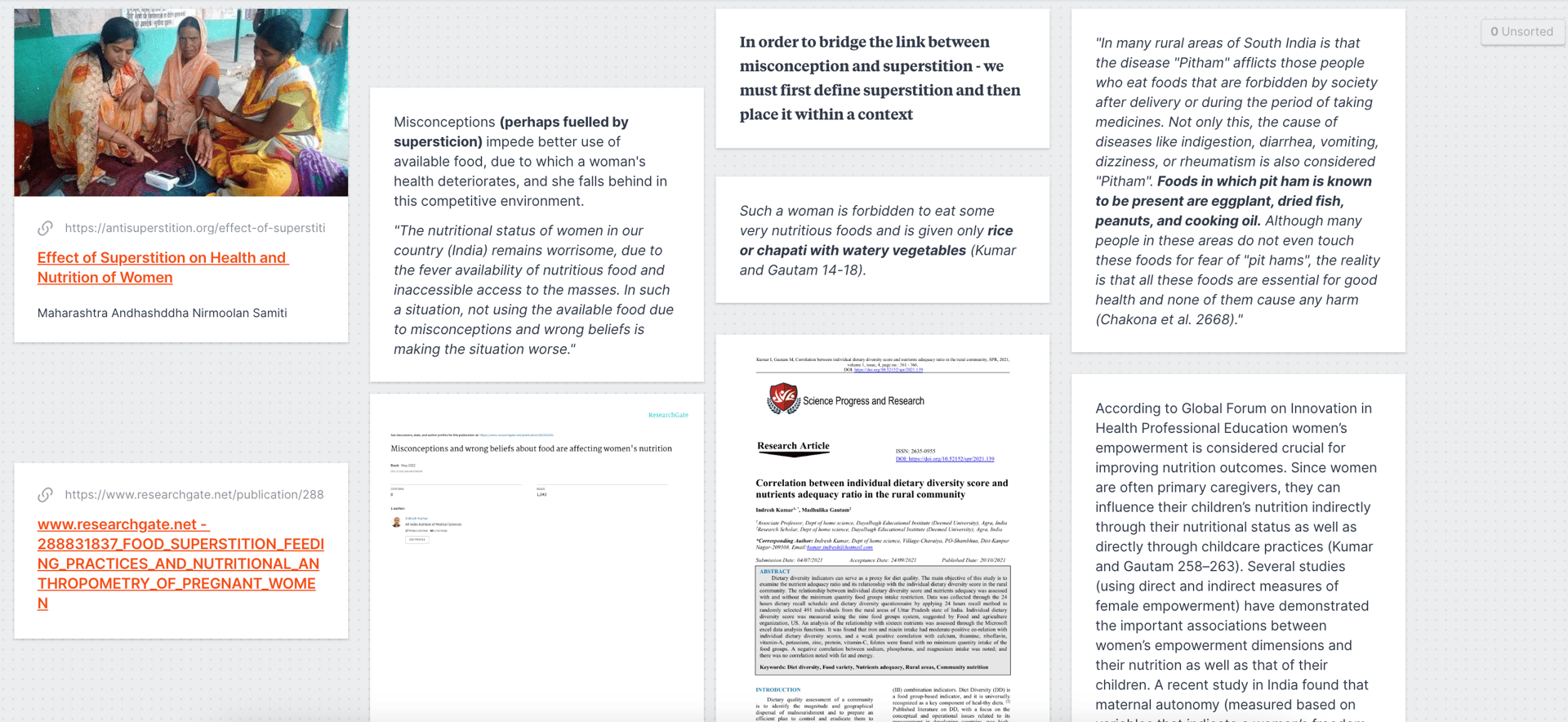Nurture Knot: service design for community care
Nurture Knot: service design for community care
Nurture Knot is a multidisciplinary approach to Service Design that uses textiles as a vessel for community care - specifically, postnatal nutritional needs of new mothers - through a synthesis of art, tradition, and science. It emerged from a desire to design for women and our collective love for food.
Timeline: 1.5 months
Role (group of 5): Ground research in India, product design, prototyping, documentation
Tools: Milanote, Adobe Illustrator, Dall-E
THE CHALLENGE: There are numerous food superstitions prevalent across the world, passed down through generations via social lore and often propagated by misinformation. While some of these superstitions aim to protect people from potential harm, others lack scientific basis and hinder the consumption of nutritious and flavorful foods.
THE CONTEXT: Food superstitions and misconceptions surrounding dietary behaviour across many cultures around the world continue to negatively impact women and girls. This often results in malnutrition, which can be particularly detrimental to pregnant women, postpartum mothers, and their newborn babies. It is essential for replenishing nutrient stores depleted during pregnancy and childbirth, promoting healing, and supporting the production of breast milk. A well-balanced diet can help prevent complications such as anaemia and fatigue, while also providing the energy and nutrients needed to care for both the mother and her newborn, both during and after the birth.
OVERVIEW
Nutrition & New Mothers:

RESEARCH QUESTION
Are there superstitions that impact the nutrition of women in India? Do they promote healthy habits or are they more often detrimental? Can we do some myth-busting? Can we uniquely present our findings in an impactful way?
Outcome: Product & Service
Nurture Knot is a food parcel wrapped up in a square of fabric inspired by the Asian Bojagi/Furoshiki parcel. It contains 3 food recipes along with all the necessary ingredients to prepare these meals. They are designed to be nutritious and support both mother and baby.
How might we care for mothers beyond?
PROPOSED OUTCOME


Offerings
The care package includes 3 nutritious meals for new mothers.
Myth-busted meal prep
Reusability
The care package wrapped in the Furoshiki Textile can be reused as a baby swaddle.
PROPOSED OUTCOME
Textile is made with soft organic cotton suitable for a baby's skin.
Cotton fabric
Locally found
Each package has local textiles and ingredients that speak to the user.


Being a group of 5 from diverse backgrounds, we all decided to play to our strengths and research what we knew. Each member focused on the myths of a particular global region: India, Nigeria, and South Korea. We then curated recipes for the box that were indigenous to that region. This allowed for the project to be informed by diverse groups and truly become a universal product for all!
Due to a lack of indigenous information on the internet, a significant number of phone calls to my mother and grandmother, back in India, underscored the project's relevance and also informed our decisions of recipes that would become a part of this care package’s Indian edition. I believed that this kind of generational firsthand information was beneficial to creating a truly authentic user experience.
Divide & Conquer:
METHODOLGY






Furoshiki is a Japanese fabric wrapping technique, used to wrap lunch boxes. We believed that it served as the perfect symbolic gesture that enveloped new mothers in care while promoting eco-friendly alternatives to packaging. It also has a universality due to its correspondence to the wrapping of Indian Dabbas.
Since a lot of my secondary research was based in the state of West Bengal in India, I decided to use a textile synonymous with that region. The craft of Kantha embroidery, known for its intricacy and storytelling through fabric, embodies a sense of warmth that aligns with the nurturing spirit of our project. By incorporating Kantha's distinct patterns and vibrant colours, I aimed to infuse the Furoshiki wrapping technique with a uniquely Indian identity. I later realised that this fusion of styles highlights the universality of caring and sharing across cultures, making the "Indian Furoshiki" a symbol of interconnectedness. The patterns on this unique fabric are woven around the myths of Papaya fruit.
Textiles for Furoshiki:
DESIGN




The project was among 10 selected for the showing out of 1000 proposals.
RCA Hanger Gallery, London
SHOWCASE














